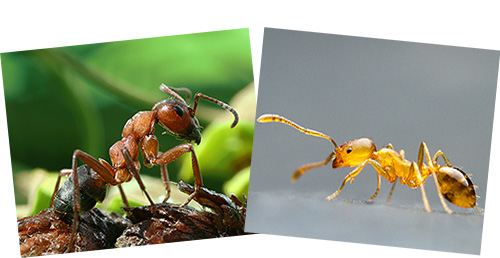
The red house ant and the red wood ant are two completely different species of ants. They differ from each other not only in size and appearance, but also in their biology: the red ant that lives in the forest is known for its outstanding building abilities and activities for the destruction of forest parasites, while domestic red ants have evolved to the unicolonial nature of their nest, which ensures their highest survival and active distribution in areas that seem completely inconvenient for them.
Representatives of these two species are most easily distinguished by size: if the red forest ants measure from 4 to 9 mm, then the domestic red ant barely reaches 3 mm. Therefore, if there are small red ants in the house, whose paws can hardly be seen, these are definitely pests, and not random guests from the forest.

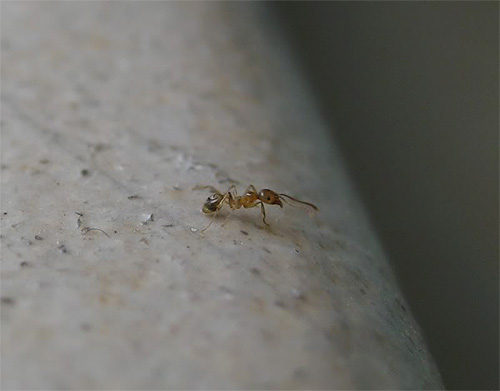
On a note
In terms of size, only the uterus of a domestic ant can be confused with a working forest one. But in general, the queen ant of both domestic and forest red ants always has a more characteristic body shape with an enlarged chest, and its coloring differs from that of the forest counterpart.
These two species are well distinguished by their coloration: red house ants are completely brown with two thin light transverse stripes on the abdomen.These stripes are especially noticeable in the uterus.
The red forest ant has only a red chest and the bottom of the head: the back of the head and the entire abdomen are black. The photo shows a worker ant of this species:

By the way
No less clearly, small red ants differ in their character: if the defender of the forest is quite capable of painfully biting a person, then domestic pharaoh ants do not bite at all.
But even more these two species differ from each other in the features of their biology ...
Red forest ant: features of biology, nutrition, photos
The red forest ant is one of the most characteristic ants of the forest zone of Russia in general. It has a slender body common to ants, a red, almost red chest and lower head, a black abdomen and nape, as well as two shiny velvety bandages on the abdomen.
The uterus of the red forest ant has the same color as the working individual, but is larger in size - up to one and a half centimeters.
It is interesting
In the very abdomen of each ant there is a gland containing a large amount of formic acid. The insect can spray this acid several centimeters around itself.
Most of all, red forest ants are famous for arranging huge, up to 2 meters high, anthills. Such heaps are formed from the earth and food debris that insects carry outside, equipping their underground chambers. When a pile reaches a certain size - such that it begins to maintain the necessary microclimate - chambers for storing food and larvae begin to be organized in the pile itself.
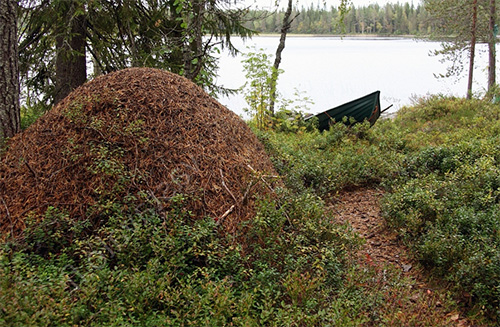
Forest ants eat about equal amounts of other insects (they are eaten mainly by larvae) and plant products (these products are consumed by adult ants).The bulk of insects eaten by ants are forest pests: according to scientists, more than 21 thousand larvae and pupae are carried into a large anthill in one day, eating leaves, flowers and wood of various forest plants. One medium-sized ant colony protects about 1 hectare of forest from pests.
It is interesting
Up to 500,000 working ants can live in a large anthill.
An essential part of the diet of ants is the sweet excretion of aphids, the so-called honeydew.
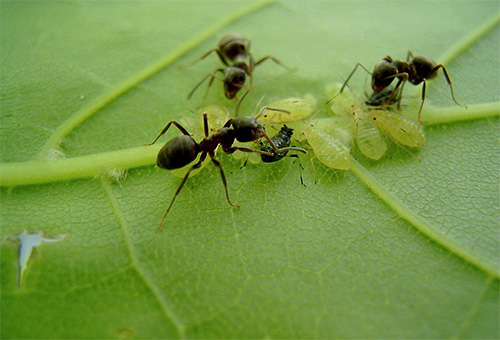
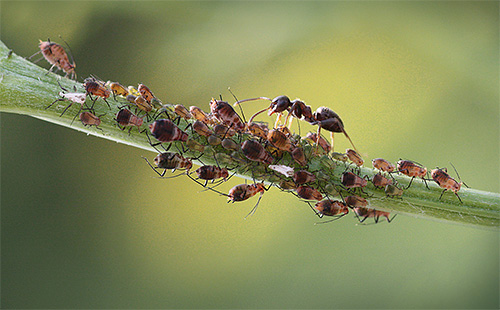
Red wood ants have their own roommates and parasites. For example, Lomekhuz beetles live in their anthills, which secrete a sweet secret and can even eat ant brood with impunity. Also in the anthill there are rove beetles that feed on the remains of the ant table and even smaller ants. And the parasites of these ants are some types of ticks and riders.
In the photo - a red ant attacks a caterpillar.
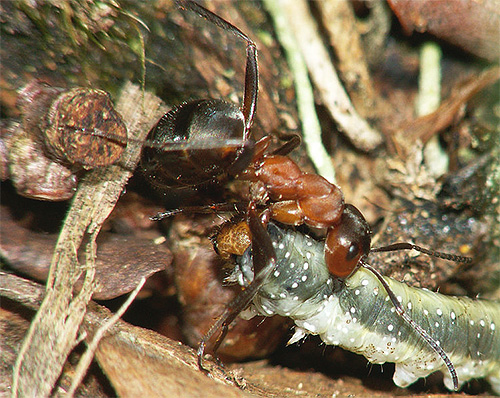
Red wood ants are distributed almost throughout the entire forest zone of Eurasia. In Siberia, they are collected, dried, and an alcohol tincture is prepared from them, which is used to treat diseases of the joints and neuralgia. Partly because of this, partly because of the destruction of the anthills themselves, this species is becoming rare in some regions and is today taken under protection.
The uterus of red forest ants and features of their reproduction
The reproduction of red forest ants is worth a separate story. The queen of red ants is not able to create a new colony on its own, and after the summer, which occurs mainly in mid-July, young females necessarily return to the anthill of their own species.
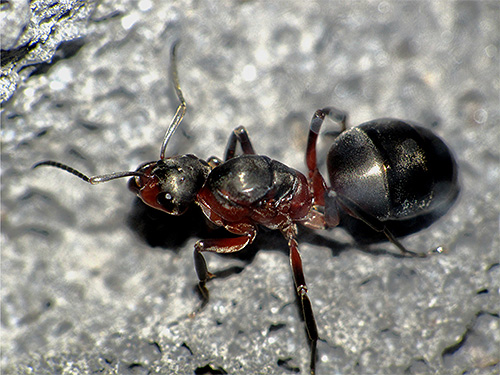
There they live either until the old queen dies and replace it, or until the colony becomes too large and the colony has to divide with the formation of a layer. At the head of such a layering, a young fertilized uterus becomes.
It is interesting
It is because of this specific method of reproduction that forest ants move very slowly and with difficulty to new places. If for the introduction of another species it is enough to bring a hundred or two queens caught after the summer to a new area, a colony of red forest dwellers must be nurtured to a more or less independent state and only then transported to a new place.
In the photo - the uterus of red ants:
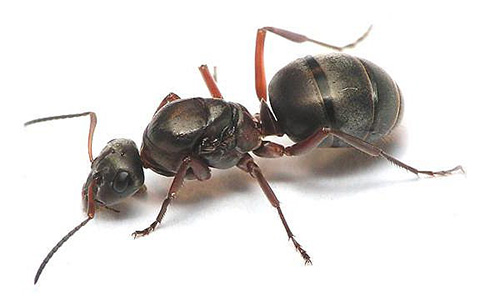
In general, red wood ants almost never have polygyny: only one queen breeds in their anthill.
It is interesting
Studying how red ants reproduce, scientists have found that sometimes a fertilized uterus can penetrate into an anthill of a related species, in which, for one reason or another, the native queen died. Ants adopt a new queen, and within a year the population of the anthill is completely replaced: new ants of a different species replace workers dying of old age or dying while looking for food.
Another interesting detail of the reproduction of this species is the fact that in one year either only males or only females can fly out of one anthill. This separation prevents ants from the same colony from interbreeding.
Domestic red ant: a malicious pest of kitchens
Red ants at home are completely different insects. They are also called pharaoh ants, since they were first discovered during excavations of the Egyptian pyramids, but India is considered their true homeland.
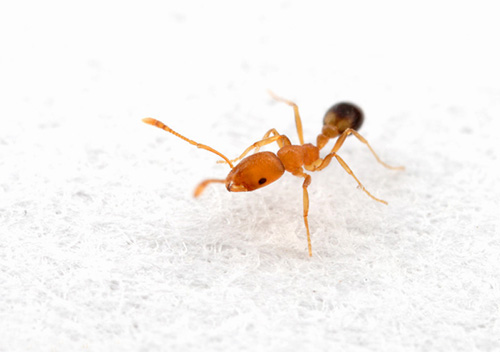
In the conditions of Russia, they are not able to exist outside heated human premises, and therefore they settle only in apartments, residential buildings and enterprises. Little red ants do not differ in any creative activity at home, and settle in various crevices, spaces behind furniture, carpets and baseboards.
Small red ants in the kitchen and in other rooms feed on any organic waste - crumbs left by open food, garbage covered in a secluded place.
In the photo - domestic red ants on the food path:

They do not disdain almost anything and therefore feel quite comfortable in almost any room.
Pharaoh ant colony
A colony of red house ants differs from a colony of forest ants in that several queens can simultaneously exist and breed in it. Moreover, domestic red ants are constantly actively creating child nests - in the kitchen, in pantries, in front rooms - having close ties with the main colony, but feeding independently and increasing in numbers. If one such nest dies, the entire colony remains unscathed. That is why pharaoh ants are so difficult to get out of the room.
The uterus of red domestic ants (in the photo - on the right) lives 4-5 years, it is larger than working individuals and has a characteristic color:
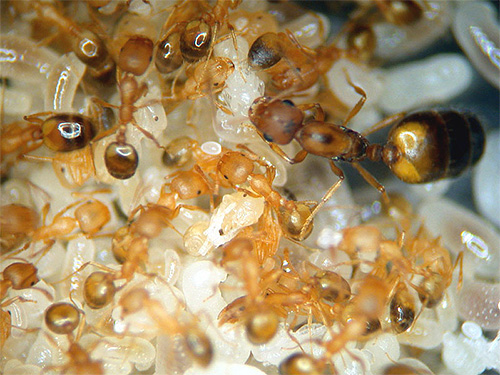
It is interesting to note that despite the most important function for the colony, the queen of the red domestic ant is not at all a “queen” - worker ants calmly kill the queens that stop working, or change them between anthills.
In general, if red ants are wound up at home, it is worth preparing for a difficult and very long struggle - in most cases it will not work to get them out in a day or two. But if you know what the red ants are afraid of, it is quite possible to get rid of them by the systematic use of the necessary means.
What are red ants afraid of?
The real natural poisons for red domestic ants are:
- borax and boric acid
- corn flour
- raw yeast, especially beer yeast
- vinegar
- vegetable oil.

There are also substances whose smells repel ants. Among them are kerosene, denatured alcohol, turpentine, ammonia, wormwood, tansy. However, the use of all these funds is justified only to prevent the entry of ants into the room.
If insects have already started in the house, powerful poisonous agents - insecticides should be used to combat them. Moreover, most of these modern tools are quite safe for humans.
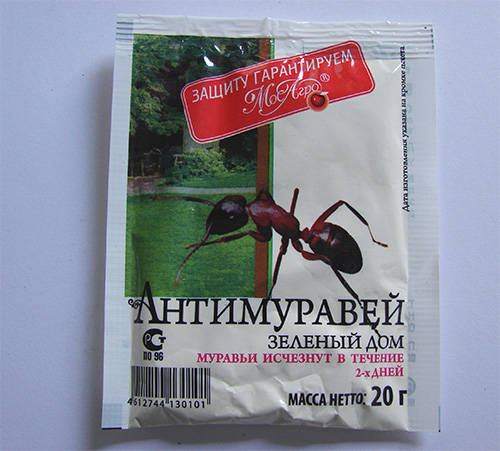
But if a red forest ant was accidentally met in the house, you should not destroy it. It is better to carefully catch and take it out into the street. There, every such little worker will be very useful.
Red forest ants drag branches, stones and insects into the anthill


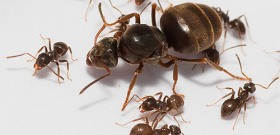

Thank you! Very interesting!